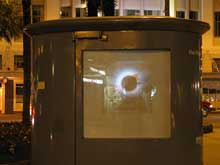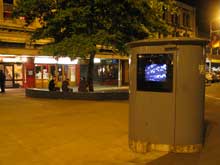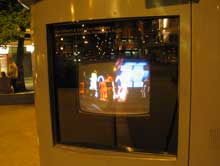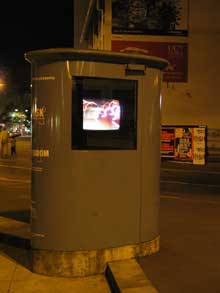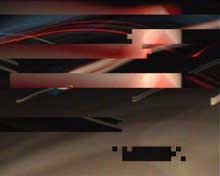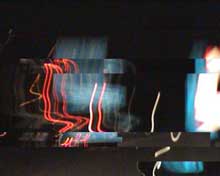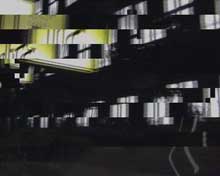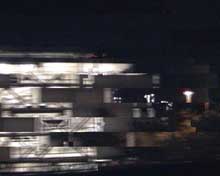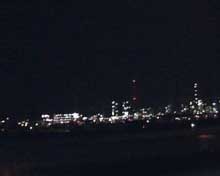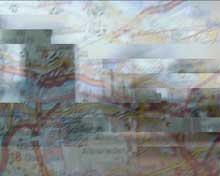 |
|||||||||
|
|
| ...Acknowledged as Detail, Repeating In Place | ||||||||||||||||||||||||
|
Acknowledged as Detail, Repeating In Place ‘Acknowledged as Detail, Repeating In Place’: notes for an audio-visual-textual collaboration “Sign here and the ink will fade in conditions of its own choosing, an icon overcome by the conditions of its control” Tom Mandel, Realism “that the vanishing point might be on every word” - Lyn Hejinian, Gertrude Stein: Two Lectures 1 What repeats? At the simplest level: a recorded loop of holiday digicam footage, captured while travelling on a highway. Visual material nearing the banal and inconsequential, but containing all the drift of the travelling eye as it focuses on the fleeting outside from a place of contradictory stasis. The half-thoughts that flare and recede while immersed in that moment, captured in the grey area between place and place, a durational zone which, in this particular instance, manifests as footage of an industrial area in Germany which, while non residential, borrows the scale and appearance of a city, with the glowering Moloch of industrialisation a faint murmur just discernable. And all this seeded with the love of the amateur, which available, accessible recording technologies has given us in many guises, the throwaway footage which, blurred and fractured, has its own aesthetic structure, one linked to partiality, breakdown and malfunction, to technologies exposing their restrictions at the failure of the narratives of totality and progress, the disinclination to preserve the illusion of the image’s seamlessness and transparency. Previously, Ina Johann’s experiments with the moving image have had an historic and materialist impetus, focused around grainy, diaphanous layers of auction-found film reel footage. In these films, the hindsight-aesthetic vernacular nostalgias of a store of silent, washed out super 8 home movie sequences from New Zealand’s drifting imagistic memory banks conflate the poignantly mortal fray of imperfectly stored celluloid film, slowly breaking down into its constituent organic and chemical elements. The found footage is then edited together in non-narrative sequence, with attention to structural, formal relationships and transparencies of process as paramount compositional devices. In the particular situation of their screening, that of the live audio-visual event, the films have shared space, time and methodology with electronic soundscapes sourced from field recordings and then reworked via digital processing1. These poetic/filmic interventions point toward the lightning-fast replacement of media with media - but also the reality that recording technologies cannot replace each other. The way information - and meaning - is conveyed changes with the technologies available. There is, for example, an ontological difference between the unique curves of the handwritten signature and the typewritten standardisation of text, or the grooves of a lathe cut vinyl record and the laser-decipherable data of a CD. The lag, the grey area of redundancy, which appears initially as slowness and clunkiness, becomes fertile domain for artistic departure and cultural analysis when obsolescence has rendered economic/social value negligible, and latent possibilities can be activated. It’s a small window in which we can reflect on the aesthetics permitted by particular media forms, and the speed at which they become distant and lost to us increases. But objects in the rear vision mirror can be closer than they appear. With Acknowledged as Detail, Repeating In Place the medium is recent, but no less attention has been given to the texture of its workings than that given to the archival super-8 footage, or that given by Johann elsewhere, in other media, within the particular mediumistic bounds (and she is often self-bound to such parameters, finding this more reductive, neo-modernist strategy a fertile one for her purposes) of her sculptural works or her works on canvas. The pixel as principal building block of the digital image, as fundamental to its form as the gestural mark is to painting, but of a different register, is the key to this film, and here, seemingly, we leave the organic, flickering beauty of film behind for something harsh, digital, streaky, clunkily blocked, but, in that, surprisingly tactile, with the imperfections and randomness of tiny Quicktime movie files seen on small fuzzy computer screens, of badly compressed MP3 files imperfectly downloaded skipping and cutting out too soon. But then, like a ghost of media’s past, the painterly gesture recurs in the fluid swoop of lights slowed down, filmic like scratches and paint-brushed marks by Len Lye, curved as the signature. Technologies do not replace each other, but in the artist’s hands, and the extension of those hands through the prosthetics of technology, the learning is accumulative. 2 But this still only part of the story. The hegemony of the visual fluctuates, revealing its partial and fragmented other like a buried memory. Two other recording technologies are also present, their playback going on simultaneously: sound and writing. A voice drives a disembodied post-lyric poetic narrative entitled, in its written form, ‘a centre, positioned. night and train’. Its writing originally rested (however momentarily) on the desire, within the lyric, to defuse any focus on a linear, chronological, autobiographical, narrative “I” in favour of an active centre of seeing/hearing which was positioned as neither detached nor immersed, subject nor object, singular nor multitudinous, nor always manifest (“the coordinates of self converging on solitude / but decentred, essentially, in between / the trains stammering in…”). In effect, writing is conceived as an active space where the self-as-writer is caught in the act of channelling the world through a series of momentary subjectivities loosely connected, ‘centres’ made of words which are then implied by, although not identical to, the words that have alighted and finalised themselves on the page. To underscore this hesitancy of positioning: three introductions like retakes, overlays of the same cyclic moment: “the location of person” “…of a body” “…of a persona” : the mediated (words, images, technologies) stuttering in the subject, a flicking between perspectives, angles, shots. Like a dream I once had of looking at a person, and every second they were drawn or painted in a different way, seeming to shift and flicker in space, while remaining ostensibly still. Hence the focus on perception, on drift and disconnection, on the self-referentiality of writing while travelling. The ‘location of person’ of course deeply dependent on how language places, and how language is placed. If the essence of narrative is ‘having a goal’, then here we are with John Cage when he says “the goal is not to have a goal”. Or: the goal is the work’s communication to an audience. Activating the voice of “a centre…”’s text seemed an inevitable experiment. The written poem’s kinship with radio’s immediacy, fluidity and multiform structure was strongly palpable from its conception. To engage with the potential to multitrack voice, to add other sound elements, and to work with phonetics, was to allow the poem to break further with its seeming finality, and to initiate another, perhaps more relevant conversation, with a different type of audience. When spoken, the text becomes a transmission, and the speaking voice reads, now literally, from the vantage point of its own shifting position. It becomes a deferred address (“the letter / in which unreadable cities occlude / with lines all knowledge…”) to a listener-reader-viewer. The chance to derive another form of permanence, not an artifactual one arising from an exclusively 'literary' state, but one arising instead from a continual communication with the listener etching into attention and memory like the sound emitting from the grooves of a record. The word forms do not approximate the ‘realism’ of everyday speech, but are poetic, distilled. Their activation in a radiophonic realm allows for further syntactic intervention and reworking, more than writing can allow. The audio mix provides a space where carefully researched material can co-exist with or be pushed into conflict with the improvisatory and the haphazard, a grafting process which produces large blocks and small splinters of form which are conceptually ‘digital’. Sentences malfunction and sit like partial artefacts, their linear architecture stacked, grafted and repeated, budding from unlikely angles. Words and syntactical patterns recur in slightly different forms and circumstances. The voice itself interchanges, oscillates and collides like opposing radio frequencies. Sharing this with the images of buildings and lights that break down, that harden and soften, that shard and stutter, and flow by, visually, on the screen. As with the inclusion of other sound that is sourced from the visual process of recording, implying in itself a more sonic apprehension of visual media. The linear breakdown is, in one sense, progressive. First the text is spoken ‘as written’, and then its integrity is destabilised in time, recurring in different forms, like a scrambling genetic code, composed of fragmentary, repetitive and episodic anecdotes, where a particular sign might be reversed, exchanged, or confused with another. Linking in to earlier experiments by the author where existing spoken narrative was macerated both into new, sparser narratives using isolated words cut and pasted into different sequences, and also further into non-semantic phonetic form, with the sonic marginalia normally edited out of radio interviews, such as the breaths and sighs, the rustling of paper, the uncertain tapering sounds at the ends and the beginnings of words, becoming the central material of the composition. To understand voice as sound, rather than transparent carrier of written text, heightens the gestural, embodied nature of language. In the acoustic sphere of a radio piece, the voice realises in practice what language on the page, even the virtual pages of a journal such as Aught2, displays in potentia. It denies us the leisurely activity of reducing language to a sequence of isolatable words, creating instead a fusion of oral poetic form with new media technology, investigating what happens to storytelling in an image-centred culture, with the vague recollections, the partially implied digressions strung together into a fragmentary, arbitrary and ‘noisy’ structure, the mechanisms of recording replicating memory’s fragmented recall of events. Linking into the history of electro acoustic literature and artistic text/voice experimentation prevalent since the advent of the invention of the tape recorder, the engagement of text with voice and sound is a next step on the road to material engagement with the world. This trajectory belongs to the legacy of a more peripheral-vision version of ‘realism’ that has learnt from John Cage to take in the distractions while reading as part of the reading itself: of traffic noise, of architecture that flows by a moving window: of what can be inhabited and what must go. And then, switching perspective, placing being and speaking inside the traffic: a car, a train as a travelling shelter in which the illusion of a centre is momentarily preserved. And the use of those momentary fixities as the only positions from which to write, to create, to think, to ‘know’. In a world of no-time, to write distraction, and take in the distractions while writing as part of the writing itself. And given a notebook or a laptop and a stretch of solitude, words will cluster like bee swarms around this illusion (‘each thought / an untidy kernel of gold / flaring on the distilled, colourless hour, where / visible, fidgeting with unlit / cigarettes / uneasy in sleep or / sleepless’). Such centralities decay and cycle, as the voice moves through cities, states, versions of its own fixity, as a constant embarkation and reversal into sonic embodiment, into grain where each sentence becomes a pull against fixity that also returns to stasis, like a dial switching restlessly between stations. 3 The shared space of collaboration, initiated as an investigative process into the possibilities of writing, sound and image being linked by common threads, has allowed certain bleeds between media, certain collectivisations of authorship. Significantly, all of the sound not generated by the primary voice in the project is taken from the visual sequences. Here, the image capturing device is also a sound capturing device. Unlike the silenced visual arena in previous technologies of representation (painting, photography, or early film), here we have imperfectly captured field recordings of the wind, and traffic noise, as well as, occasionally, another voice, near inaudible, in Swiss-German, human but automated in the sense that it is depersonalised to the function of a traffic report heard over the radio while driving: “detours are signposted…” before diving back into noise. Then there are the various distillations and stretchings in which, planned and unplanned, the primary sound sequences are affected by distortion, feedback, editing techniques and filters. That the image can be ‘heard’ is not unusual in our time and place, but unlike mainstream film or television, the sound in Repeating in Place is not treated as ancillary to the image. The prevailing eye/ear hierarchy becomes completely cyclic when the attention to the relationship of sound and vision also affects the way the visible material is presented. When the texture of image mimics the acoustic disturbance of radio static. When white noise is, in effect, visually rendered. In Acknowledged as Detail,Repeating in Place, images and sounds of a place and a time are captured as a loop, a repetition. So in one sense, by the time you see it, the seeing is already dead. The moment is archival. This is the nature of recorded representation. Still, the existence of technologies of recording and storage, as well as the availing of the dynamic potential of a public art site to connect radiophonic and visual material with activities in the diverse social domain of public space, recognising the experience of the contemporary urban environment as a shifting and unstable tissue where technologies, bodies, and geographies cross-pollinate, also allows us to press this fixed moment back into the day, and activate it in combination with other cities, locations, viewers. To feed these fixed forms back into an unbounded, unstable real. As Kate Fagan, Australian poet and musician, writes: “ & each time the moment falls /the emphasis of the moment falls /into time differently / continued presencing / if not the present / these caring accretions, / the life that has gone / acknowledged as detail, / repeating in place / each time the tongue moves /it moves into time differently / doing, undoing /a bundle of precisely-wired blue / & this & this / appearing”3. And there is our title. Sally Ann McIntyre, October 20051.Johann’s live visual sequencing accompanied Peter May and Adam Hayward’s performance of the initial contributions to their site specific sound project based around the Catchpool region near Wellington, firstly at Static Mansion in Christchurch, and later in Wellington at the Catchpool project’s culminating performance. She has also worked as visual collaborator with Christchurch based audio artist John McCallum. 2. the poem was published in Aught issue 8 (2002). Full text can be found at : http://people2.clarityconnect.com/webpages6/ronhenry/mcintyre8.htm 3.Taken from the sequence ‘return to a new physics’ in Fagan, Kate; The Long Moment; Salt Modern Poets, Salt Publishing 2002
|
|||||||||||||||||||||||
